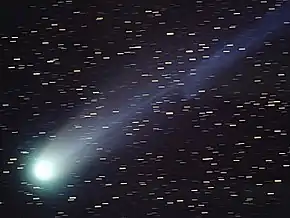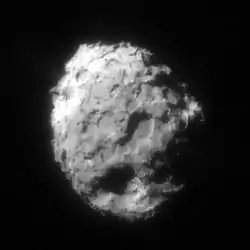6P/d'Arrest
6P/d'Arrest (also known as d'Arrest's Comet or Comet d'Arrest) is a periodic Jupiter-family comet in the Solar System, orbiting between Mars and Jupiter. It passed 0.15124 AU (22,625,000 km; 14,059,000 mi) from the Earth on August 12, 1976.[4] The next perihelion passage is 2021-Sept-17 when the comet will have a solar elongation of 95 degrees at approximately apparent magnitude 10.[5]
| Discovery | |
|---|---|
| Discovered by | Heinrich Louis d'Arrest |
| Discovery date | June 28, 1851 |
| Alternative designations | 1678 R1, 1851 M1, 1857 X1, 1910c, 1923b, 1950a, 1963f, 1970d, 1976e, 1982e, 1987k |
| Orbital characteristics A | |
| Epoch | 2009-Jan-10 (JD 2454841.5) |
| Aphelion | 5.637 AU |
| Perihelion | 1.353 AU |
| Semi-major axis | 3.495 AU |
| Eccentricity | 0.6127 |
| Orbital period | 6.54 a |
| Inclination | 19.51° |
| TJupiter | 2.71 |
| Earth MOID | 0.34 AU (51 million km) |
| Dimensions | 3.2 km[1] |
| Last perihelion | March 2, 2015[2] August 14, 2008 |
| Next perihelion | 2021-Sept-17[3] |
The comet last came to perihelion (closest approach to the Sun) on March 2, 2015,[5] but it was in an unfavorable apparition as it had a solar elongation of less than 30 degrees from October 2014 until May 2015.[6]
In 1991, Andrea Carusi and Giovanni B. Valsecchi (Istituto Astrofisica Spaziale, Rome), and Ľubor Kresák and Margita Kresáková (Slovak Astronomical Institute, Bratislava) independently suggested this comet was the same as a comet observed by Philippe de La Hire in 1678.[7][8]
It was first observed by Heinrich Ludwig d'Arrest, in Leipzig, Germany, on 28th and 30 June 1851.[7]
The comet nucleus is estimated at about 3.2 km in diameter.[1]
6P/d was one of a trio of comets targeted by the ill-fated CONTOUR mission, an unmanned discovery program mission, that was launched but contact was lost soon after reaching orbit.
If it had been functional, the planned date for CONTOUR's study of d'Arrest would have been 2008, after visiting two other comets.[9]
Around 2007, 6P/d was one of nine comets examined for a comet sample return mission study.[10] In the 2010s a comet surface sample return mission was selected as the New Frontiers Program finalist, but the recently studied comet 67P was chosen as the selected target.
See also
References
- "JPL Small-Body Database Browser: 6P/d'Arrest" (last observation: 2014-03-10). Jet Propulsion Laboratory. Retrieved February 25, 2010.
- Syuichi Nakano (May 28, 2008). "6P/d'Arrest (NK 1625)". OAA Computing and Minor Planet Sections. Retrieved February 18, 2012.
- MPC
- "JPL Close-Approach Data: 6P/d'Arrest" (last observation: 2014-03-10). Retrieved February 22, 2012.
- Seiichi Yoshida (March 16, 2014). "6P/d'Arrest". Seiichi Yoshida's Comet Catalog. Retrieved October 29, 2014.
- "Elements and Ephemeris for 6P/d'Arrest". Minor Planet Center. Archived from the original on October 29, 2014. Retrieved October 29, 2014. (0006P)
- Kronk, Gary W. (2001–2005). "6P/d'Arrest". Archived from the original on June 22, 2006. Retrieved June 7, 2006. (Cometography Home Page)
- Carusi, A.; Valsecchi, G. B.; Kresák, Ľ.; Kresáková, M.; and Sitarski, G., Periodic Comet d'Arrest = Comet la Hire (1678), IAU Circular 5283, 1 (1990)
- "Contour: Missing in Action - Sky & Telescope". Sky & Telescope. July 23, 2003. Retrieved December 28, 2017.
- Weaver, Hal; A’Hearn, Mike; Fountain, Glen. "Comet Surface Sample Return" (PDF). Retrieved December 31, 2017.
External links
- Orbital simulation from JPL (Java) / Horizons Ephemeris
- 6P/d'Arrest at CometBase database
- Elements and Ephemeris for 6P/d'Arrest – Minor Planet Center
- 6P/d'Arrest – Seiichi Yoshida @ aerith.net
- 6P – Gary W. Kronk's Cometography
| Numbered comets | ||
|---|---|---|
| Previous 5D/Brorsen |
6P/d'Arrest | Next 7P/Pons–Winnecke |


